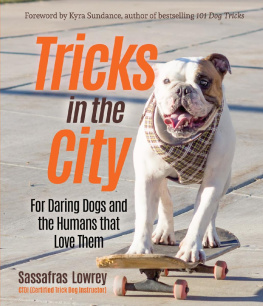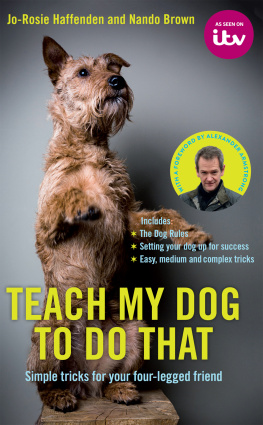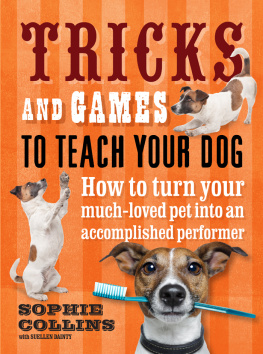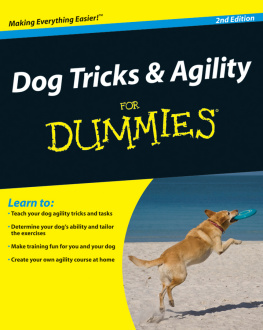Dog Tricks
Best smart dog tricks to teach your dog in record time
ANTHONY PORTOKALOGLOU
Copyright 2017 by Anthony Portokaloglou
All rights reserved. No part of this publication may be reproduced, distributed or transmitted in any form or by any means, without prior written permission from the author.
Disclaimer Notice
The techniques described in this book are for informational purposes only. All attempts have been made by the author to provide real and accurate content. No responsibility will be taken by the author for any damages cost by misuse of the content described in this book. Please consult a licensed professional before utilizing the information of this book.
I hope you will enjoy my book. I would be very grateful if you would consider leaving a review. Thank you!
Introduction:
Chapter One General Training Tips
Chapter Two Training with a clicker
Chapter Three Teaching Kisses
Chapter Four Bark on Command
Chapter Five Shake Hands
Chapter Six Fetch
Chapter Seven Roll Over
Chapter Eight - Play Dead / or Shoot the Dog
Chapter Nine Spin
Chapter Ten Stand on Hind Legs
Chapter Eleven Sit Pretty
Chapter Twelve Hug
Chapter Thirteen High Five
Chapter Fourteen- Army Crawl
Chapter Fifteen - Collect garbage
Chapter Sixteen Skateboard
Chapter Seventeen Handstand
Chapter Eighteen - Back Up
Chapter Nineteen - Open and close doors
Chapter Twenty - Fetch a drink from the Fridge
Chapter Twenty-One Beg
Chapter Twenty-two Teaching Your Dog to Find It
Chapter Twenty-three Dance
Introduction:
People are amazed when house-pets can do specialty tricks, are obedient, and a pleasure to be around. Any pet can be taught how to do several tricks, it simply takes patience, consistency and lots of love and affection for your pet. If you desire to have a pet that is enjoyable to be around, obeys, and is fun to show off to your friends; then read on! Dog Tricks: Best smart dog tricks to teach your dog in record time is exactly what you have been looking for!
Chapter One General Training Tips
- Be liberal with your attention and affection.
Everyone, including pets, love attention and affection. Too many pet owners are liberal with their displeasure or correction and stingy with their praise. It should be the opposite. When your dog is behaving well make sure you give your pet lots of praise and affirmation of that good behavior. Tell him hes a good dog and you can even go over the top with praise when your dog has pleased you, and its a good thing! You can never give your pet too much praise or too much love.
You pet may not be social with other dogs, or may be social with dogs but apprehensive around people. Pay attention to your pets idiosyncrasies, dont insist your pet interact when they are obviously not comfortable; it could cause an unwanted situation or possibly pet problems down the road. Just like people have personalities and characteristics pets do as well. It is not that they cannot be modified, but be aware of what they are in the training process for a happier training experience for both you and your pet.
- Be clear in your commands.
It is oftentimes not enough just to say no to your pet. Lets say he is jumping on something or someone, dont just say no; but you may want to say no and then command that he sit. Make sure your pet understands what you are expecting him to do or not do. Remember although animals can learn hundreds of human words and phrases, they do not understand as a human does. They are easily confused. That is why you must be clear and concise. In order to get the same behavior, you must do the same command or signal .
Commands need to be uniform. If more than one person is dealing with the pet, then everyone needs to use the same commands. If your pet is jumping on furniture and you are using the down command and someone else is saying get off your pet will have difficulty learning what is expected. If you correct a dog for a behavior one time and then let him get by with it another time it is unkind and unfair; and inconsistent behavior will extend the training time. The golden rule of pet training is that you MUST be consistent!
- Be realistic in your expectations.
To change behavior, you must understand that you will invest time. You will repeat commands over and over. You will need patience. Often normal dog behavior such as digging, jumping, barking will take the most time to change. The longer a dog is allowed bad behavior the longer it will take to correct it, that is why training as a puppy is so much easier than an older canine. It is never too late to change the behavior some will just take longer than others, so be realistic .
- Nutrition is very important.
Insure your dog has a high-quality diet with the right amounts of protein. If you have a sedentary dog that is confined to smaller living quarters you would not give him the same amount as a dog that is working with cattle all day. Cheating on a quality diet for your dog will just insure that you have vet bills in the future and a shorter life span for your friend. A veterinarian is a good resource to help you develop the right diet for your pet.
- Your dog will behave in what is reinforced, not necessarily what you want.
If you dog is doing something you really dont care for, then it is more likely that it is a behavior that has been reinforced in the past. Lets say a dog gets a toy and barks so that you throw it. If you throw the toy, he understands that barking will get you to play. If you say no and he consistently barks and then you throw the toy, you have reinforced that excessive barking and persistence will get him his way. Before long, your dog will be barking to get his way. So, what do you do? Ignore his barking and do not throw the toy until he has stopped. Or give him an alternate command such as sit or down before throwing his toy.
Using treats is a proven effective way to encourage good behavior in dogs. But, you are not limited to treats. Use the surroundings around you and each interaction with your pet is a learning and teaching opportunity. Use praise, touch, loving inflection in your voice, games, walks, and play time. Remember the behavior should produce the treat, the treat should not produce the behavior!
It is wise to confine your dog to a crate, a room, or an area and let them earn freedom as they mature and show they can be responsible enough not to destroy things. Some common mistakes pet owners make is giving too much freedom too quickly. Too much freedoms leads to things getting torn up, accidents, and bad behavior. A crate is a great way to give your pet a safe space and to restrict your pet. If a crate isnt possible a child gate or dog proof room can be helpful.
Chapter Two Training with a clicker
Clicker training is an awesome, science-based technique to commune with your dog. Some feel that it is easier than standard command-based training techniques.
Next page














